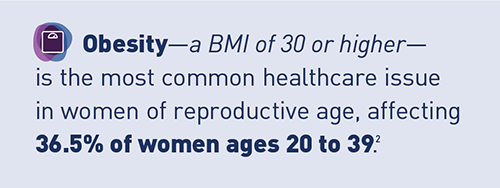 You and the pregnant women you care for share common goals: a healthy pregnancy, a safe delivery, and a healthy baby. To achieve these goals, you need to work together with pregnant women.
You and the pregnant women you care for share common goals: a healthy pregnancy, a safe delivery, and a healthy baby. To achieve these goals, you need to work together with pregnant women.
Obesity—having a body mass index (BMI) of 30 or higher—is one of the most common health issues in U.S. women of reproductive age,1 affecting 36.5% of women ages 20 to 39.2 Evidence shows that obesity is associated with increased risk of health complications during pregnancy and after delivery. Research also notes several potential effects on women, fetuses, and, in the long term, children.1
Working together means empowering pregnant women by framing BMI as just one factor in a healthy pregnancy, and by educating them about using BMI and other risk classifications to develop individual healthy pregnancy plans.
Pregnancy for Every Body aims to help providers and pregnant women work toward these common goals.
Risks Associated with Obesity During Pregnancy
A pre-pregnancy BMI at or above 30 increases the risk for several health issues, including:
- Miscarriage
- Congenital anomalies, including neural tube defects such as spina bifida and congenital heart anomalies, as well as cleft palate and atypical limbs
- Fetal hydrocephalus
- Maternal heart problems
- Maternal sleep apnea
- Maternal proteinuria
- Maternal nonalcoholic fatty liver disease
- Gestational diabetes
- Preeclampsia
Risks during delivery
Obesity may increase the risk of:
- Longer labor
- Cesarean delivery
- Inflammation of the lining of the uterus (endometritis)
- Rupture of delivery-related wounds
- Venous thrombosis
- Potentially dangerous problems related to anesthesia
Long-term risks to children
Children born to mothers who had obesity during pregnancy are at higher risk for:
- Metabolic syndrome
- Asthma
- Obesity
- Autism spectrum disorders
- Developmental delay
- Attention-deficit/hyperactivity disorder1,3
How Can I Provide the Best Care to Pregnant Women with Obesity?
Pregnancy for Every Body collaborated with the American College of Obstetricians and Gynecologists (ACOG) and other provider groups to gather resources and recommendations on providing prenatal care to women with obesity. Check out the following resources to learn more about caring for plus-size pregnant women.


 BACK TO TOP
BACK TO TOP